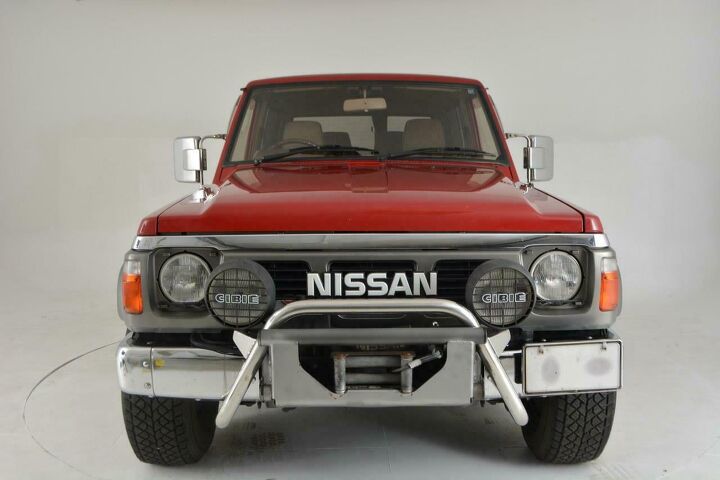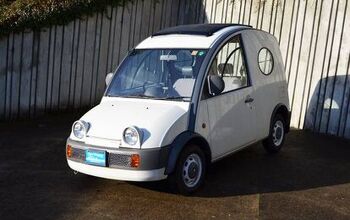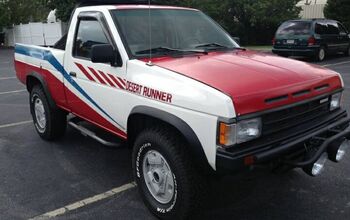Rare Rides: Patrol the Desert in This 1989 Nissan Safari

The Patrol has forever been Nissan’s answer to the Toyota Land Cruiser, as both brands compete for rough and tumble SUV customers. Today’s Rare Ride represents just how many creature comforts can be added to a go-anywhere truck.
Presenting the Nissan Safari from 1989.
The Patrol started production in 1951, aping the looks and function of the Willys Jeep. It borrowed the name too; sometimes it was just called a Jeep. Mostly intended for military use, the bare-bones first generation lasted through 1960.
With the debut of the second generation, production expanded to include more body styles: Patrol now offered hardtops, vans, and a pickup truck. Distribution expanded as well, and the Patrol was sold (as a Nissan) at Datsun dealerships in North America between 1962 and 1969.
It was 1980 before the third-generation Patrol began production, known as the 160 series. Comfort and equipment came into play for the first time, as this generation saw the introduction of an automatic transmission. Accompanying the transmission option were new trim levels. Deluxe examples included luxuries like air conditioning and power steering.
A fourth-generation (Y60) Patrol started production in 1987, bringing us to today’s Rare Ride. In a turn from prior generations, a coil suspension replaced the old leaf springs and brought refinement to travel. Power steering was standard and, if buyers spent enough money, they’d have the benefit of front and rear disc brakes. Automatic transmissions in this generation were all of the four-speed variety, while manuals had five forward gears. Engines ranged between 2.8 and 4.2 liters, all of them inline-sixes.
The Japanese market received the fourth-generation Patrol as the Safari. While models for other markets had a 12-volt electrical system, the Safari had a 24-volt. Today’s Rare Ride is a decked-out short-wheelbase example from the end of the Eighties. It has the largest 4.2-liter diesel engine. Said diesel propels all the tape stripes, power equipment, and tweedy seats through an automatic transmission. The Safari asks $14,900 and is located in Philadelphia.
[Images: seller]

Interested in lots of cars and their various historical contexts. Started writing articles for TTAC in late 2016, when my first posts were QOTDs. From there I started a few new series like Rare Rides, Buy/Drive/Burn, Abandoned History, and most recently Rare Rides Icons. Operating from a home base in Cincinnati, Ohio, a relative auto journalist dead zone. Many of my articles are prompted by something I'll see on social media that sparks my interest and causes me to research. Finding articles and information from the early days of the internet and beyond that covers the little details lost to time: trim packages, color and wheel choices, interior fabrics. Beyond those, I'm fascinated by automotive industry experiments, both failures and successes. Lately I've taken an interest in AI, and generating "what if" type images for car models long dead. Reincarnating a modern Toyota Paseo, Lincoln Mark IX, or Isuzu Trooper through a text prompt is fun. Fun to post them on Twitter too, and watch people overreact. To that end, the social media I use most is Twitter, @CoreyLewis86. I also contribute pieces for Forbes Wheels and Forbes Home.
More by Corey Lewis
Latest Car Reviews
Read moreLatest Product Reviews
Read moreRecent Comments
- Jalop1991 expensive repairs??? I've heard that EVs don't require anything that resembles maintenance or repair!So let me get this straight: as EV design and manufacture technology, and as battery technology, improves over time, the early adopters will suffer from having older and ever-rapidly outdated cars that as a result have lower resale value than they thought.And it's the world's obligation to brush their tears away and give them money back as they realize the horrible mistake they made, the mistake made out of some strong desire to signal their virtue, the mistake they could have avoided by--you know--calmly considering the facts up front?Really? It's Tesla's obligation here?If Tesla continued to manufacture the Model 3 (for example) the same way it did originally when the Model 3 was introduced, Tesla would not have been able to lower prices. And they wouldn't have. But they invested heavily in engineering in order to bring prices down--and now the snowflakes are crying in their cereal that the world didn't accommodate their unicorn dreams and wishes and wants and desires.Curse the real world! How dare it interfere with those unicorn wishes!
- Canam23 I live in southwest France and I am always surprised at how many Teslas I see on the road here. Mind you, I live in a town of 50k people, not a big city so it does seem unusual. On the other hand I also see a lot of PT Cruisers here (with diesel engines) so there's that...
- Slavuta Union....
- Paul Alexander The Portuguese sports car.
- Bd2 I hope they are more successful with Hyundai. Quality and ATPs only stand to improve with solid union support.







































Comments
Join the conversation
RH drive... perfect for a rural mail carrier who also needs 4x4 capability!!!
Does it still have the 24V electrical system? While such things have merits for reliability reasons, maintainability would take a huge hit unless you have military-like economies of scale. What do you use for lightbulbs, for instance?